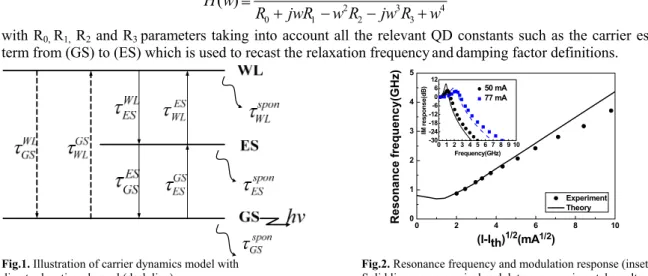HAL Id: hal-00805214
https://hal.archives-ouvertes.fr/hal-00805214
Submitted on 28 Mar 2013HAL is a multi-disciplinary open access
archive for the deposit and dissemination of sci-entific research documents, whether they are pub-lished or not. The documents may come from teaching and research institutions in France or abroad, or from public or private research centers.
L’archive ouverte pluridisciplinaire HAL, est destinée au dépôt et à la diffusion de documents scientifiques de niveau recherche, publiés ou non, émanant des établissements d’enseignement et de recherche français ou étrangers, des laboratoires publics ou privés.
Modulation Response of Semiconductor Quantum-Dot
Lasers
Cheng Wang, Frederic Grillot, Jacky Even
To cite this version:
Cheng Wang, Frederic Grillot, Jacky Even. Modulation Response of Semiconductor Quantum-Dot Lasers. SIOE2012 ”Semiconductor and Integrated Electronics”, Apr 2012, United Kingdom. �hal-00805214�
Modulation Response of Semiconductor Quantum-Dot Lasers
Cheng Wang(1), Frédéric Grillot(1),(2) and Jacky Even(1)
(1) Université Européenne de Bretagne, INSA, CNRS FOTON, 20 avenue des buttes de Coesmes, 35708 Rennes Cedex 7, France
(2) Telecom Paristech, Ecole Nationale Supérieure des Télécommunications, CNRS LTCI, 46 rue Barrault, 75013 Paris, France
Email: cheng.wang@insa-rennes.fr
Introduction
A new expression of the modulation transfer function is derived for quantum dot (QD) lasers. The analytical approach is based on a cascade relaxation model taking into account three QD energy levels such as the wetting layer (WL), the 1st excited state (ES) as well as the ground state (GS). From the analysis, we demonstrate that the carrier escape from (GS) to (ES) is responsible for a non-zero resonance frequency at low bias powers.
Modulation Response based Analysis
The device under study consists of an InAs/InP(113)B QD laser [1]. As depicted in figure 1, the carrier dynamics in such lasers includes a direct relaxation channel from (WL) to (GS) [2]. Applying a small-signal analysis to the rate equations allows extracting a new expression of the QD laser s modulation response:
0 2 3 0 1 2 3 ( ) R H w 4 R jwR w R jw R w ≡ + − − + (1)
with R0, R1, R2 and R3 parameters taking into account all the relevant QD constants such as the carrier escape
term from (GS) to (ES) which is used to recast the relaxation frequencyanddamping factor definitions.
0 2 4 6 8 1 0 1 2 3 4 5 0 0 1 2 3 4 5 6 7 8 9 10 -30 -24 -18 -12 -6 0 6 12 50 mA 77 mA IM r e s p o n s e (d B ) Frequency(GHz) R e s o n a n c e fr e q u e n c y (G H z) (I-Ith)1/2(mA1/2) Experiment Theory
Fig.1. Illustration of carrier dynamics model with Fig.2. Resonance frequency and modulation response (inset)
direct relaxation channel (dash line) Solid lines are numerical and dots are experimental results.
Figure 2 show the measured squared resonance frequency (dots) as a function of the pump current deviation from the threshold value. Inset of figure 2 shows the experimental modulation response (dots) measured at two different pump currents. Numerical results obtained from (1) lead to a relative good agreement (solid) with the experiments. However, at large current injections, because the gain compression is not considered in our model, the calculated resonance frequency (solid) is found to be higher than the experimental results. Analytical calculations also point out that the carrier escape from (GS) to (ES) induces a non-zero resonance frequency at low bias powers. This frequency offset is larger than the one due to spontaneous emission only in quantum well (QW) lasers [3]. Similar behaviour is also observed when plotting the calculated damping factor as a function of the squared resonance frequency (not shown). Such a deviation from linearity at low resonance frequencies is also attributed to the carrier escape from (GS) to (ES), which leads to a larger damping factor offset as compared to conventional QW lasers [4].
Conclusions
A new analytical expression of the modulation response has been derived for a QD laser. From the analysis, it is found that at low bias powers, carrier escape from (GS) to (ES) provokes a non-zero resonance frequency associated to a stronger damping rate. These results are of first importance for a better understanding of the carrier dynamics in QD lasers for high-speed applications.
References
[1] A. Martinez et al., Appl. Phys. Lett., vol. 93, 021101, (2008).
[2] K. Veselinov et al., IEEE J. Quantum Electron., vol. 43, pp. 810-816, (2007). [3] L.A. Coldren et S.W. Corzine, Wiley, New York, (1995)
